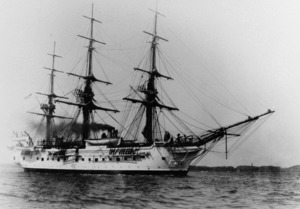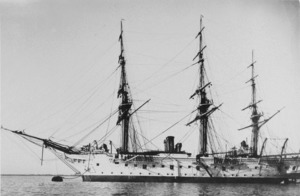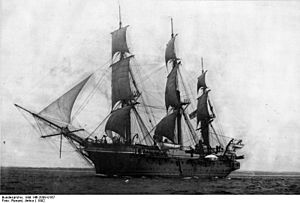SMS Nixe facts for kids

Nixe in 1899
|
|
Quick facts for kids Class overview |
|
|---|---|
| Preceded by: | Carola class |
| Succeeded by: | Charlotte |
| History | |
| Name | Nixe |
| Namesake | Nixe |
| Ordered | August 1882 |
| Builder | Kaiserliche Werft Danzig |
| Laid down | August 1883 |
| Launched | 23 July 1885 |
| Commissioned | 1 April 1886 |
| Stricken | 24 June 1911 |
| Fate | Sold, 1 April 1923 and converted into a lighter, broken up in 1930 |
| General characteristics | |
| Type | Screw corvette |
| Displacement | Full load: 1,982 t (1,951 long tons) |
| Length | 63.3 meters (207 ft 8 in) (loa) |
| Beam | 13.2 m (43 ft 4 in) |
| Draft | 5.52 m (18 ft 1 in) |
| Installed power |
|
| Propulsion |
|
| Sail plan | Full ship rig |
| Speed | 10.4 knots (19.3 km/h; 12.0 mph) |
| Range | 1,480 nautical miles (2,740 km; 1,700 mi) at 8 kn (15 km/h; 9.2 mph) |
| Crew |
|
| Armament |
|
The SMS Nixe was a special kind of ship called a screw corvette. It was built for the German Imperial Navy (Kaiserliche Marine) in the 1880s. Construction started in August 1883, and the ship was launched in July 1885. It officially joined the fleet in April 1886.
Even though it was built, the Nixe was already a bit old-fashioned. It didn't have enough powerful guns or speed for fighting. Despite this, it was finished as planned. The ship was also tricky to steer and was easily pushed around by strong winds. For almost 15 years, the Nixe served as a training ship for young naval cadets and apprentice sailors. It went on many long trips across the ocean, often visiting South America, the West Indies, and the Mediterranean Sea.
From 1906 to 1910, the Nixe was used as a main ship for the High Seas Fleet. However, the German Parliament (Reichstag) decided to cut its funding. In June 1911, the ship was removed from the official navy list. It then became a barracks ship, a floating home for sailors, until April 1923. After that, it was sold and renamed Hulk C. A private company bought it and turned it into a lighter, which is a type of barge used to carry goods. It worked as a lighter from 1925 to 1930, still called Nixe, before it was finally taken apart.
Contents
Building the SMS Nixe
After a big war called the Franco-Prussian War (1870–1871), the German Imperial Navy wanted to grow stronger. They needed more ships to protect Germany's growing trade around the world. They also wanted to be ready for any future conflicts. In the 1870s, Germany ordered many corvettes. These ships were good for long journeys but not very strong in battles.
In August 1882, the navy decided to build a new corvette, the Nixe. At this time, General Albrecht von Stosch was in charge of the Imperial Admiralty. Later, General Leo von Caprivi took over in 1883. Caprivi believed that new ships should be better balanced. He thought they needed more fighting power.
Even though Caprivi wanted stronger ships, the navy had to follow an older plan from 1873. So, the Nixe was built as planned, even though it wasn't very powerful. It had a weak engine and not enough strong guns. This made it not very useful as a combat ship. Historians have wondered why no one stopped its construction. They think Caprivi's newness to the job might have played a part. Also, debates in the German Parliament might have pushed the navy to stick to the old plan.
What Made Her Move?
The Nixe was 63.3 meters (207 ft 8 in) long overall. It was 13.2 m (43 ft 4 in) wide and had a draft of 5.52 m (18 ft 1 in). When fully loaded, it weighed about 1,982 t (1,951 long tons). The ship's body was made with iron frames and wooden planks. These planks were covered with copper to stop sea creatures from sticking to the hull. This was important for long trips where there were no shipyards to clean the hull. The ship's hull was divided into nine waterproof sections.
The Nixe usually had a crew of 27 officers and 331 sailors. But when it became a training ship, it carried 17 officers and 354 sailors. This included 125 naval cadets who were learning to be officers. The ship carried several small boats, like a picket boat, a launch, cutters, yawls, and dinghies. A single rudder controlled the steering. The ship was not very good in rough seas. It would swing sideways a lot when sailing with the wind. Without its sails, the rudder had to be turned a bit to keep the ship going straight. It also slowed down a lot when sailing against waves.
The ship was powered by a steam engine with two cylinders. This engine turned a single propeller. Two coal-fired boilers made the steam. The smoke from these boilers went up a funnel that could be pulled down. The ship was designed to go 9 knots (17 km/h; 10 mph) (knots), but it actually reached 10.4 knots (19.3 km/h; 12.0 mph) during tests. It could carry 125 t (123 long tons) of coal. The Nixe could travel about 1,480 nautical miles (2,740 km; 1,700 mi) (nautical miles) at a speed of 8 knots (15 km/h; 9.2 mph). When it was first built, the Nixe had a full set of sails to help save coal on long voyages. These sails were later reduced.
Ship's Weapons
The Nixe was armed with eight 12.5 cm (4.9 in) guns. These were breech-loading guns, meaning they were loaded from the back. The ship carried 800 shells for these guns. Later, two of these guns were removed. The guns could shoot up to 5,000 m (16,000 ft). Later in its life, the ship also got two faster-firing 8.8 cm (3.5 in) guns and four 37 mm (1.5 in) Hotchkiss revolver cannons. The 8.8 cm guns had 300 shells.
Life of the SMS Nixe
Early Years: 1886–1894
The Nixe was built at the Imperial Shipyard (Kaiserliche Werft) in Danzig. Work started in August 1883. It was launched on July 23, 1885. At the launch, the shipyard director named the ship after the Nixe water spirits from German stories. The ship officially joined the navy on April 1, 1886. After some tests, it went to the Imperial Shipyard in Kiel to be set up as a training ship.
The Nixe took its first short training trip with young sailors from May 17 to 31. Its first big trip overseas began on June 15. This journey took it to South and Central America. It visited places like Bahía Blanca and the West Indies. In St. Thomas, it joined other training ships. They all sailed back to Germany together, arriving in Kiel on July 25, 1887. The Nixe then took part in navy exercises in August. After that, it served as a guard ship in Wilhelmshaven until April 1888.
The Nixe continued its training duties in April 1888 with short trips in the Baltic Sea. On June 4, it started another long trip to the West Indies and Canada. It returned to Kiel on September 9, 1889. The ship was then taken out of service on September 30. It was brought back into service on April 9, 1890. More Baltic training trips followed. On June 10, it began another trip to the West Indies, visiting Venezuela and Norfolk, Virginia in the United States. It returned to Kiel on August 25, 1891, and joined fleet exercises until September 18.
The training program in 1892 was similar, but the overseas trip went to the Mediterranean Sea. During this trip, some crew members got sick with typhoid. After returning in September, the ship joined fleet exercises. Then, on September 23, it started a winter training trip, again to the West Indies. This was the first time the Nixe carried cadets from the Naval School (Marineschule). When it returned to Germany on March 15, 1894, the Nixe was taken out of service for an update at the shipyard in Danzig.
Later Years: 1897–1930
The Nixe was ready for service again on April 1, 1897. In late September, it began a winter training trip to the West Indies. On its way back, it was sent to Kamerun (now Cameroon). This was to attend the funeral of Ndumbe Lobe Bell, a local leader who supported Germany. The funeral was on December 12. The Nixe left Kamerun on January 12, 1898, and arrived in Kiel on March 19. After this, it had some regular maintenance.
The ship went on training trips in the Baltic Sea. On August 15, it started its next overseas trip to South America. It stopped in Brazil and Argentina. While in São Francisco do Sul, Brazil, some of its crew visited a German community in Joinville. The Nixe reached Kiel on April 1, 1899, and went into the shipyard for another major check-up.
After its repairs, the Nixe began its next big training trip in mid-May, again to the West Indies. While in the Caribbean Sea, a revolution started in Venezuela. The German government ordered the Nixe to visit the ports of La Guaira and Puerto Cabello. This was to protect German citizens and their businesses from the fighting. On November 6, other ships took its place. This allowed the Nixe to continue its training duties. It returned to Kiel on March 26, 1900. The year's training started on May 25 with a short trip to Vlissingen, Netherlands.
Then, it went on a training trip to St. Petersburg, Russia. When it came back, the ship was taken out of service. This was because the navy needed its crew for other tasks. Many sailors were sent to China to help stop the Boxer Uprising. The navy had planned to update the ship in 1901. But another ship, the Gneisenau, was lost. This meant the navy could only afford to make small changes to the Nixe's sails. It was not brought back into service until November 1, 1906. From then on, it was only used as a headquarters ship for the High Seas Fleet.
In 1910, the German Parliament (Reichstag) did not give money to keep the Nixe active. So, it had to be taken out of service again on May 18. The Nixe was officially removed from the navy's list on June 24, 1911. It was the last sailing ship of the Imperial Navy still on the list. It was then turned into a barracks ship in Kiel. It served in this role, connected to the Naval Gunnery School, into the 1920s.
On April 1, 1923, it was renamed Hulk C and sold to a private company. This company turned it into a sea-going lighter and gave it back its original name, Nixe. It was used by the Emil Retzlaff company until 1930. Finally, it was taken apart in Wewelsfleth.



